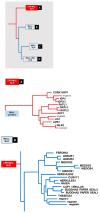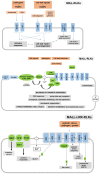Signals and Their Perception for Remodelling, Adjustment and Repair of the Plant Cell Wall
- PMID: 37108585
- PMCID: PMC10139151
- DOI: 10.3390/ijms24087417
Signals and Their Perception for Remodelling, Adjustment and Repair of the Plant Cell Wall
Abstract
The integrity of the cell wall is important for plant cells. Mechanical or chemical distortions, tension, pH changes in the apoplast, disturbance of the ion homeostasis, leakage of cell compounds into the apoplastic space or breakdown of cell wall polysaccharides activate cellular responses which often occur via plasma membrane-localized receptors. Breakdown products of the cell wall polysaccharides function as damage-associated molecular patterns and derive from cellulose (cello-oligomers), hemicelluloses (mainly xyloglucans and mixed-linkage glucans as well as glucuronoarabinoglucans in Poaceae) and pectins (oligogalacturonides). In addition, several types of channels participate in mechanosensing and convert physical into chemical signals. To establish a proper response, the cell has to integrate information about apoplastic alterations and disturbance of its wall with cell-internal programs which require modifications in the wall architecture due to growth, differentiation or cell division. We summarize recent progress in pattern recognition receptors for plant-derived oligosaccharides, with a focus on malectin domain-containing receptor kinases and their crosstalk with other perception systems and intracellular signaling events.
Keywords: Arabidopsis; cell wall; cell wall integrity; cellulose; hemicelluloses; malectin-domain containing proteins; pattern recognition receptors; pectin.
Conflict of interest statement
The authors declare no conflict of interest.
Figures



Similar articles
-
Plant cell wall-mediated immunity: cell wall changes trigger disease resistance responses.Plant J. 2018 Feb;93(4):614-636. doi: 10.1111/tpj.13807. Epub 2018 Feb 2. Plant J. 2018. PMID: 29266460 Review.
-
The Ceratopteris (fern) developing motile gamete walls contain diverse polysaccharides, but not pectin.Planta. 2018 Feb;247(2):393-404. doi: 10.1007/s00425-017-2793-6. Epub 2017 Oct 13. Planta. 2018. PMID: 29027584
-
Cellular growth in plants requires regulation of cell wall biochemistry.Curr Opin Cell Biol. 2017 Feb;44:28-35. doi: 10.1016/j.ceb.2017.01.002. Epub 2017 Jan 25. Curr Opin Cell Biol. 2017. PMID: 28131101 Review.
-
Live Fluorescence Visualization of Cellulose and Pectin in Plant Cell Walls.Methods Mol Biol. 2023;2566:269-279. doi: 10.1007/978-1-0716-2675-7_22. Methods Mol Biol. 2023. PMID: 36152259
-
Building an Artificial Plant Cell Wall on a Lipid Bilayer by Assembling Polysaccharides and Engineered Proteins.ACS Synth Biol. 2022 Oct 21;11(10):3516-3528. doi: 10.1021/acssynbio.2c00404. Epub 2022 Oct 4. ACS Synth Biol. 2022. PMID: 36194500
Cited by
-
Cellooligomer/CELLOOLIGOMER RECEPTOR KINASE1 Signaling Exhibits Crosstalk with PAMP-Triggered Immune Responses and Sugar Metabolism in Arabidopsis Roots.Int J Mol Sci. 2024 Mar 19;25(6):3472. doi: 10.3390/ijms25063472. Int J Mol Sci. 2024. PMID: 38542444 Free PMC article.
-
The Dynamic Remodeling of Plant Cell Wall in Response to Heat Stress.Genes (Basel). 2025 May 24;16(6):628. doi: 10.3390/genes16060628. Genes (Basel). 2025. PMID: 40565520 Free PMC article. Review.
-
Learning from Salicornia: Physiological, Biochemical, and Molecular Mechanisms of Salinity Tolerance.Int J Mol Sci. 2025 Jun 20;26(13):5936. doi: 10.3390/ijms26135936. Int J Mol Sci. 2025. PMID: 40649711 Free PMC article. Review.
-
Arabidopsis WALL-ASSOCIATED KINASES are not required for oligogalacturonide-induced signaling and immunity.Plant Cell. 2024 Dec 23;37(1):koae317. doi: 10.1093/plcell/koae317. Plant Cell. 2024. PMID: 39665686 Free PMC article.
-
Advancing Engineered Plant Living Materials through Tobacco BY-2 Cell Growth and Transfection within Tailored Granular Hydrogel Scaffolds.ACS Cent Sci. 2024 May 1;10(5):1094-1104. doi: 10.1021/acscentsci.4c00338. eCollection 2024 May 22. ACS Cent Sci. 2024. PMID: 38799669 Free PMC article.
References
Publication types
MeSH terms
Substances
Grants and funding
LinkOut - more resources
Full Text Sources

